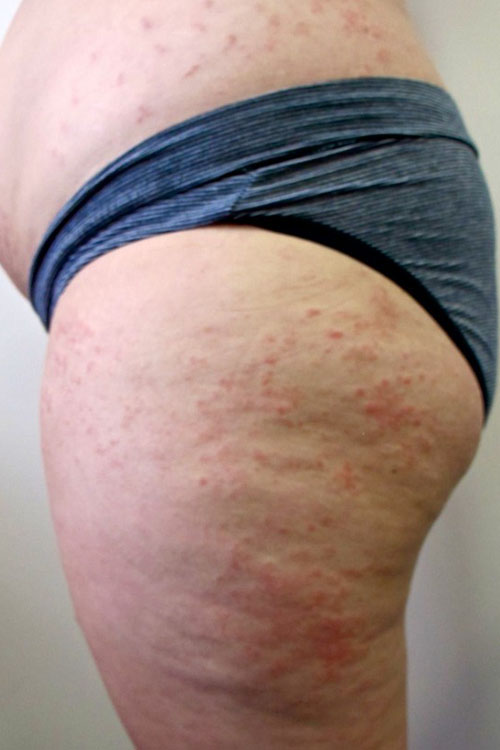Polymorphic eruption of pregnancy
Polymorphic eruption of pregnancy (PEP) (also called pruritic urticarial papules and plaques of pregnancy [PUPPP]) occurs in 1 in 120 to 200 pregnancies, and is the second most common rash induced by pregnancyBechtel, 2018Taylor, 2015. It usually develops late in the third trimester, particularly in patients who are in their first pregnancy (62.5%)Taylor, 2015 or who gain excessive weight during pregnancy.
The eruption is intensely itchy, and begins on the abdomen, typically in or near striae. As it spreads, erythematous papules coalesce to form urticarial plaques over the trunk, buttocks and limbs. See here for photos of polymorphic eruption of pregnancy. Clinical findings can be divided into three subgroups: Type I—urticarial papules and plaques; Type II—broader clinical findings of erythematous patches, nonurticarial papules or vesicles; Type III—a combination of both Type I and Type II.
Differentiating polymorphic eruption of pregnancy from early pemphigoid gestationis can be difficult. Umbilical involvement is more common in pemphigoid gestationis, compared to polymorphic eruption of pregnancy.
Polymorphic eruption of pregnancy usually resolves spontaneously within days of delivery, and does not tend to recur in subsequent pregnancies.

Photo sourced with permission from Dr Michelle McRae.

Reproduced with permission from the A-Z of Skin [digital]. Australasian College of Dermatologists. Sydney. https://www.dermcoll.edu.au/

Reproduced with permission from the A-Z of Skin [digital]. Australasian College of Dermatologists. Sydney. https://www.dermcoll.edu.au/

Photo sourced with permission from Dr Michelle McRae.
Treatment of polymorphic eruption of pregnancy involves symptomatic treatment with cooling baths, a topical corticosteroid, and a sedating antihistamine. UseTaylor, 2015:
1betamethasone dipropionate 0.05% cream or ointment topically, twice daily betamethasone dipropionate betamethasone dipropionate betamethasone dipropionate
1cyproheptadine 4 mg orally, three times a day cyproheptadine cyproheptadine cyproheptadine
OR
1dexchlorpheniramine 2 mg orally, four times a day. dexchlorpheniramine dexchlorpheniramine dexchlorpheniramine
If sedation is a concern, a less-sedating antihistamine such as loratadine or cetirizine can be used1. Consider:
1loratadine 10 mg orally, once daily loratadine loratadine loratadine
OR
1cetirizine 10 mg orally, once daily. cetirizine cetirizine cetirizine
If the response to therapy is inadequate, use a wet dressing with the topical corticosteroid.
In very severe cases when the patient is unable to sleep because of itching, refer to a dermatologist or obstetrician for consideration of oral prednisolone or prednisone.
